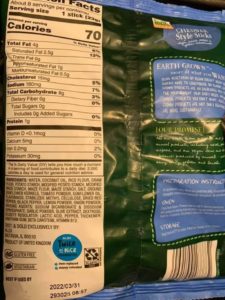By Reed Mangels, PhD, RD
The Vegetarian Resource Group was recently contacted and asked this question, “Here’s a weird one: a product labeled as vegan, with no obvious non-vegan ingredients (that I see), but 15 mg cholesterol. Is the vegan label wrong? Am I misreading one of the ingredients? … What’s this all about?”
A product that is truly vegan should not contain on the label any cholesterol, a substance produced by animals. Grains, legumes, nuts, fruits, vegetables, and vegetable oils do not have cholesterol or only contain insignificant amounts (more on this in a future blog posting). In order to address this puzzle, we need to consider where the nutrient amounts on nutrition labels come from.
According to the
FDA, the government agency responsible for food labeling, food manufacturers
should have a laboratory analyze the nutritional content of the company’s
product using specific tests. If the manufacturer of the product did this and
determined that the product contained cholesterol, it could be due to
contamination during production or it could be that the product contains small
amounts of an animal ingredient that contains cholesterol and that the products
should not be labeled as vegan.
In place of
costly laboratory analysis, manufacturers may choose to use existing
nutritional data bases and programs to calculate the nutritional content of
their food product. If a company use a nutritional data base to calculate the
nutritional content, they input all the ingredients and amounts, and a program
calculates the amounts of different nutrients in a serving of food. The
manufacturer is responsible for the accuracy of the information on the
nutrition label on their products so FDA states that calculated nutrient
content should be validated by laboratory analyses (1).
FDA discourages
companies from merely copying a competitor’s label with the assumption that the
products are similar. If FDA checked and found that a product’s composition did
not agree with its nutritional label, the firm could not claim that it acted in
good faith and should not be penalized if it copied information from a
competitor (1).
Misleading
information can be generated when nutrient databases are used. Most programs
provide users with a choice of ingredients when recipes are being inputted. An
example of the kind of error that could be introduced – if an ingredient in a
vegan product is pasta, and the person inputting the recipe into the program
chooses a pasta that contains eggs instead of a vegan pasta as the ingredient,
the recipe analysis would indicate that there is cholesterol in the product. If
the company neglected to verify this information with laboratory analysis,
incorrect label information could result. So, one possibility for there
apparently being cholesterol in a product labeled as vegan is incorrect input
of ingredients into a nutritional analysis program.
The FDA does
compliance checks in which they analyze food samples that have been randomly
collected from lots of a food – a lot could be one day’s production. FDA takes
12 subsamples, combines them into one sample and analyzes the nutrient content
of this composite. To be in compliance with FDA’s labeling regulations for
cholesterol, the amount of cholesterol determined to be in the sample by lab
analysis should be no more than 20% higher than what the label indicates is in
the product. Having an analyzed amount of cholesterol below what is stated on
the label, is “usually considered acceptable by the agency within good
manufacturing practices (2).”
Contacting the
company may be helpful in determining the cause of the apparently incorrect
label information and may alert the company to the need to correct either the
“vegan” label or the amount of cholesterol shown on the label.
1. FDA. A Food Labeling Guide. Guidance for Industry.
January, 2013. https://www.fda.gov/files/food/published/Food-Labeling-Guide-%28PDF%29.pdf
2. FDA. Guidance for Industry: Guide for Developing and Using Data Bases for Nutrition Labeling. 1998. https://www.fda.gov/regulatory-information/search-fda-guidance-documents/guidance-industry-guide-developing-and-using-data-bases-nutrition-labeling#Chapter_1
For more food labeling information see: https://www.vrg.org/ingredients/index.php
The contents of this posting, website, and our other publications, including Vegetarian Journal, are not intended to provide personal medical advice. Medical advice should be obtained from a qualified health professional. We often depend on product and ingredient information from company statements. It is impossible to be 100% sure about a statement, info can change, people have different views, and mistakes can be made. Please use your best judgment about whether a product is suitable for you. To be sure, do further research or confirmation on your own.
